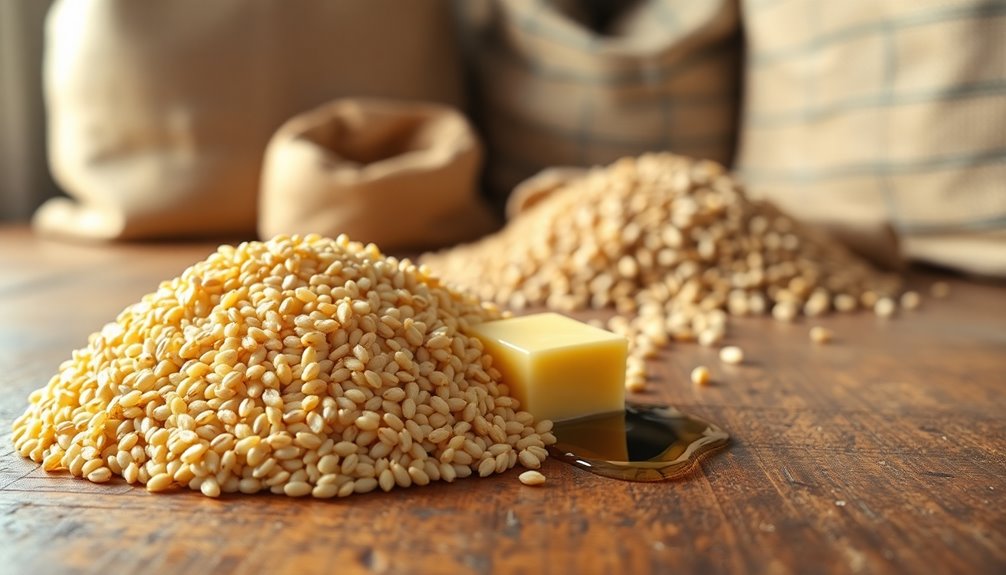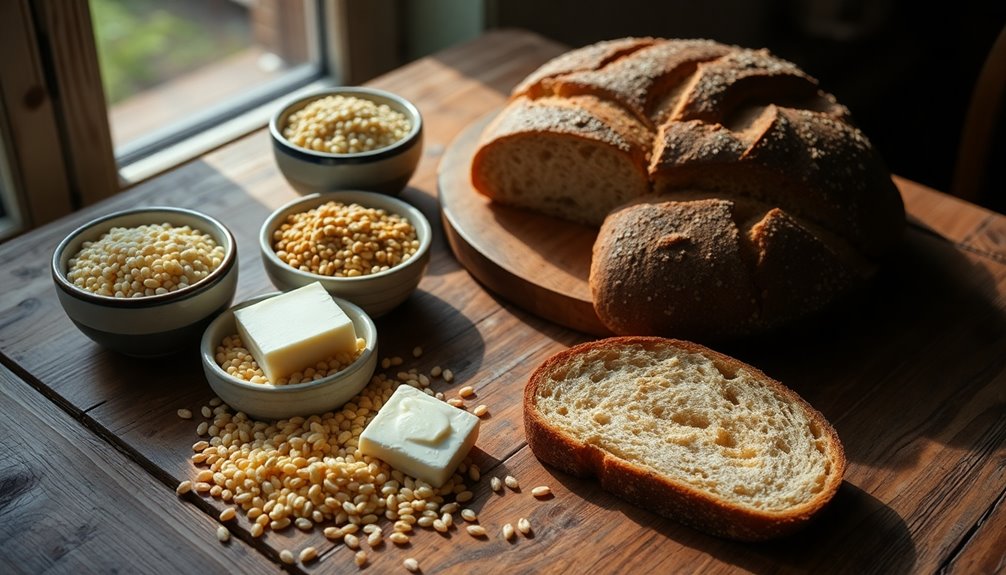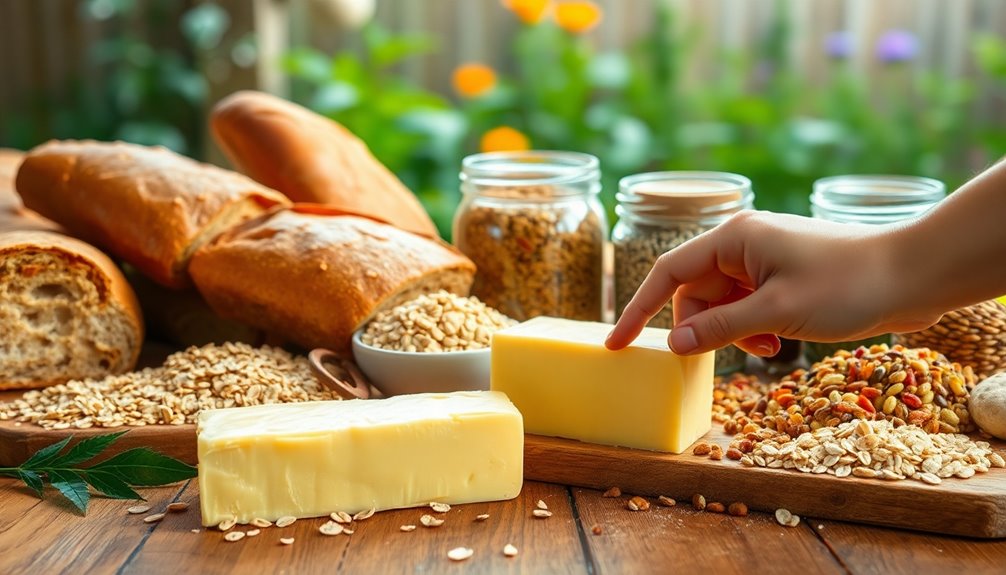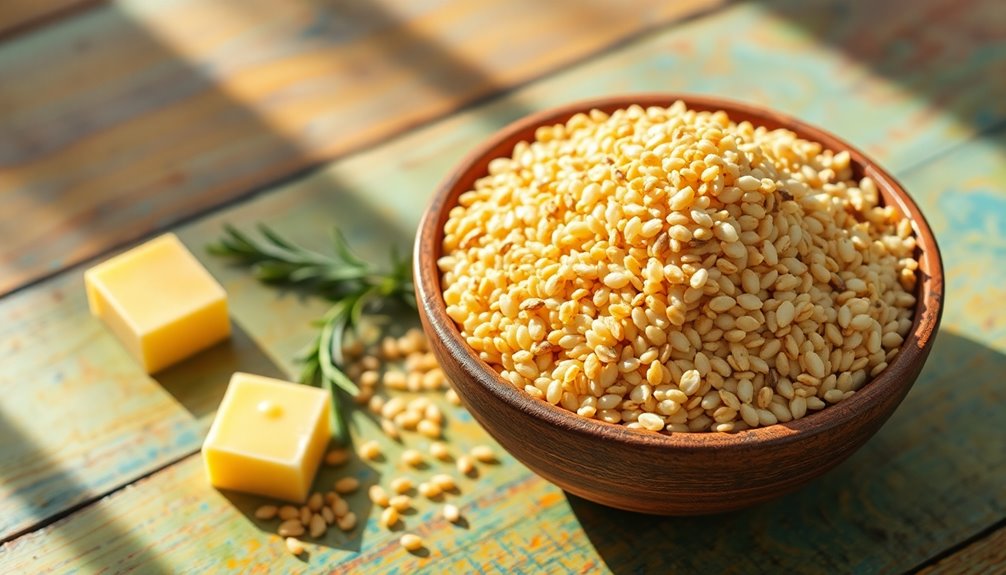You don't need whole grains to have a balanced diet. While they do provide fiber, many traditional diets thrive without them. Instead, you can focus on nutrient-dense options like vegetables and healthy fats, including butter. Non-starchy vegetables offer higher vitamins and minerals than grains. Plus, healthy fats support overall health without the blood sugar spikes associated with processed grains. It's crucial to rethink what you choose to fuel your body. There's much more to discover about how adjusting your diet can enhance your well-being and energy levels.
Key Takeaways
- Grains have historically been significant but are not essential for a healthy diet, as many traditional societies thrive without them.
- Non-starchy vegetables provide superior nutrients and fiber compared to whole grains, making them a more beneficial dietary choice.
- The glycemic index of whole grains is similar to processed options, which can lead to blood sugar spikes; less processed grains are preferable.
- Research on whole grains often relies on observational studies, which may not provide solid evidence of their health benefits compared to nutrient-dense foods.
- Focusing on healthy fats and vegetables can enhance overall health more effectively than relying on whole grains alone.
Historical Perspective on Grains

Throughout history, grains have played a significant role in human diets, but they aren't as essential as some might think. For thousands of years, humans thrived on diets without grains, relying instead on fruits, vegetables, and animal products.
Even today, traditional societies exist that maintain grain-free diets, showcasing the adaptability of human nutrition. Whole grains, defined as whole kernels like wheat berries or pearled barley, were once prepared through methods such as soaking, boiling, and fermenting.
Yet, modern consumption often shifts towards processed grain products, losing their nutritional benefits. This shift raises questions about the necessity of grains in your daily meals.
When considering your dietary choices, remember that grains aren't the only path to health and nutrition.
Nutritional Value of Whole Grains

While grains have been a staple in many diets, their nutritional value often comes under scrutiny. You might find that whole grains provide fewer nutrients per calorie compared to non-starchy vegetables.
In fact, vegetables can offer a higher vitamin and mineral content. Whole grain products do contain more fiber than processed options, but they still don't match the fiber levels found in non-starchy vegetables. Chia seeds, for instance, are rich in fiber, which can further support digestive health when incorporated into your meals, as their soluble fiber aids in promoting bowel regularity.
Additionally, it's crucial to evaluate that many claims about whole grains stem from observational studies, which aren't always reliable. Instead of focusing solely on whole grains, you might want to prioritize nutrient-dense foods like vegetables.
Ultimately, whole grains may not be as vital for a balanced diet as you've been led to believe.
Understanding Glycemic Index

Understanding the Glycemic Index (GI) can greatly impact your dietary choices, especially when it comes to managing blood sugar levels. The GI measures how quickly foods convert to glucose in your bloodstream.
For instance, white bread has a GI of 73, while whole wheat bread is slightly lower at 71. However, when whole grains are processed into flour, they often lose their health benefits, causing a spike in blood sugar similar to refined grains.
Choosing less processed options, like wheat berries with a GI of 30, can support better blood sugar management. By being mindful of the GI in your food choices, you can make informed decisions that align with your health goals.
Analyzing Research Findings

Analyzing research findings reveals the complexities behind the claims surrounding whole grains and their health benefits.
Many assertions you hear are based on observational studies rather than rigorous experimental data. This means the positive effects of whole grains might be influenced by "healthy user bias," where people who eat whole grains often lead healthier lifestyles overall.
Weak associations often emerge in dietary research, leading to skepticism about the touted benefits. You should differentiate between what's supported by solid experimental evidence and what's merely correlation.
When you consider these points, it becomes clear that whole grains may not hold the nutritional value they're often credited with. Instead, focusing on nutrient-dense foods, especially vegetables, might be a better choice for your diet.
Rethinking Dietary Choices

Rethinking your dietary choices can lead to significant improvements in your overall health. Instead of relying on grains, consider incorporating more nutrient-dense foods like vegetables and healthy fats. Here's a quick comparison to guide your decisions:
| Food Type | Nutrient Density | Fiber Content per 100g |
|---|---|---|
| Whole Grains | Moderate | 7g |
| Non-Starchy Vegetables | High | 20g |
| Healthy Fats (e.g., Avocado) | High | 7g |
Additionally, focusing on high fiber content can support digestive health and overall well-being. Incorporating antioxidant-rich foods into your diet further enhances your health by combating oxidative stress.
Frequently Asked Questions
Can Whole Grains Be Part of a Gluten-Free Diet?
Yes, whole grains can fit into a gluten-free diet, but you'll need to choose wisely. Options like quinoa, brown rice, and buckwheat provide the benefits of whole grains without gluten.
Just make certain they're labeled gluten-free to avoid cross-contamination.
While whole grains offer fiber and nutrients, focus on incorporating a variety of gluten-free foods, including fruits and vegetables, to guarantee you're getting a balanced diet that meets your nutritional needs.
What Are Some Grain-Free Alternatives to Consider?
If you think life without grains means munching on nothing but lettuce, think again!
You've got a treasure trove of grain-free alternatives waiting for you. Immerse yourself in cauliflower rice, spiralized zucchini, or chickpea pasta for a hearty twist.
Sweet potatoes and quinoa can spice up your meals too.
Don't forget about legumes and nuts—packed with protein and flavor!
Embrace these options and watch your dishes transform into culinary masterpieces!
How Can I Incorporate More Vegetables Into My Meals?
To incorporate more vegetables into your meals, start by adding them to your favorite dishes. Toss spinach or kale into omelets, mix bell peppers into stir-fries, or blend leafy greens in smoothies.
Try roasting seasonal veggies with olive oil for a tasty side. You can also snack on raw veggies with hummus or make salads the star of your meal.
Experimenting with different cooking methods can make veggies more appealing and enjoyable!
Are There Benefits to Consuming Fermented Grains?
Fermented grains can offer some benefits, like improved digestibility and increased nutrient absorption. When you consume them, the fermentation process breaks down complex compounds, making nutrients more accessible.
Plus, you might enjoy the unique flavors they bring to your meals.
However, remember that whole grains aren't the only source of nutrition. Balancing your diet with a variety of foods, especially vegetables, helps guarantee you get a wide range of nutrients.
What Role Do Grains Play in Traditional Diets Globally?
Did you know that some traditional societies thrive on grain-free diets, relying instead on nutrient-dense foods?
Grains have played a significant role in many cultures, often serving as staple sources of calories.
However, you'll find that these diets also emphasize vegetables, legumes, and animal products for their nutrients.
Exploring these global perspectives reveals a variety of dietary patterns, showing that grains aren't always essential for health and well-being.
Conclusion
So, do you really need whole grains? Well, if you fancy a diet of cardboard and air, go right ahead! But if you want to thrive, consider swapping those trendy grains for the vibrant colors of veggies and the rich taste of butter. After all, who needs fiber when you can have flavor? Embrace the freedom of choice and remember: your plate should be a canvas, not a grainy mess. Make your meals a masterpiece, not a fad!










